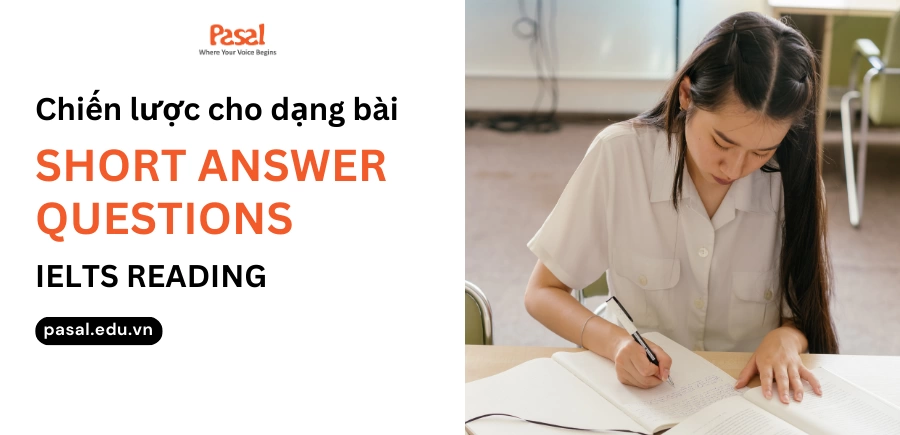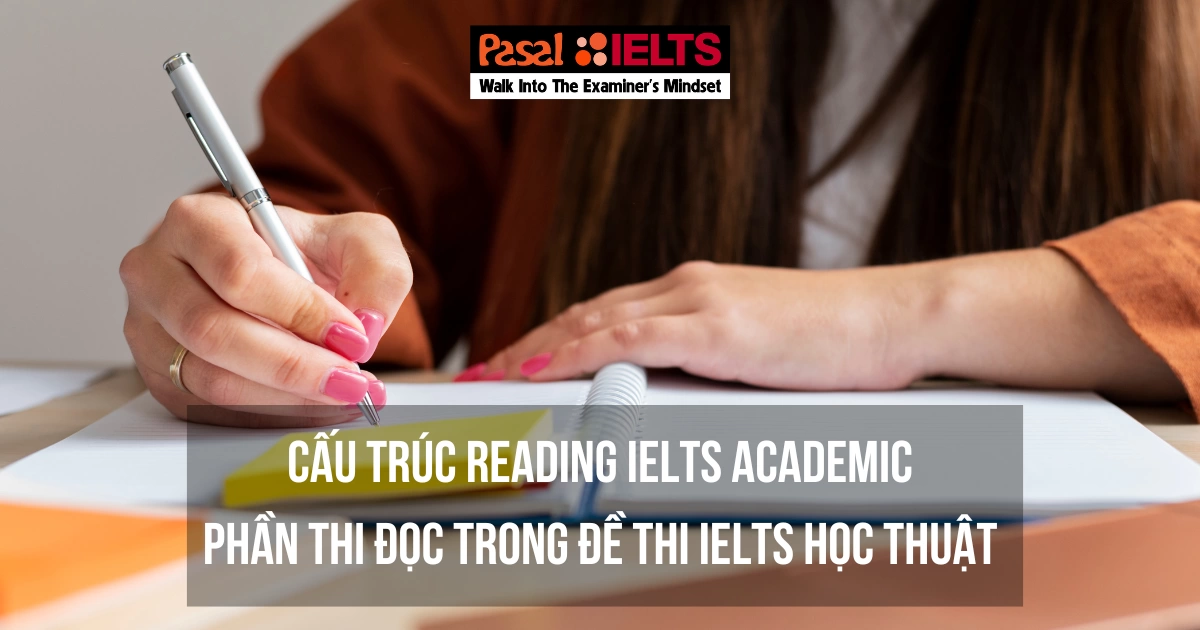Xử lý gọn dạng Matching Information IELTS Reading đạt ngay 8.0+
Matching Information IELTS Reading là một trong những dạng bài phổ biến trong đề thi IELTS. Yêu cầu của dạng bài này là nối thông tin được cho trước với đoạn văn bản có chứa thông tin đó. Đây được đánh giá là dạng bài trung bình – khó, đòi hỏi thí sinh cần có các kỹ năng tốt về Đọc hiểu. Cùng Pasal khám phá cách chinh phục dạng bài này nhé!
Tổng quan về dạng bài Matching Information IELTS Reading
Yêu cầu đề bài dạng Matching Information IELTS Reading
Cụ thể, đề bài sẽ cho biết từ 4 – 6 câu thông tin được lấy từ bài đọc và yêu cầu thí sinh tìm và xác định thông tin đó xuất hiện ở trong đoạn văn (paragraph) nào. Tuy nhiên, thông tin không được lấy giống hệt trong văn bản mà đã được paraphrase, tăng độ khó cho dạng bài này lên rất nhiều.
Tổng quan về dạng bài Matching Information IELTS Reading
Các dạng thông tin bao gồm:
-
a fact: một sự thật
-
an example: một ví dụ
-
a reason: một lý do
-
a summary: tổng kết, tổng hợp
-
a definition: một định nghĩa
Những khó khăn hay gặp khi làm dạng bài Matching Information
Với dạng bài khó như Matching Information, thí sinh cần biết được những khó khăn và lỗi thường gặp khi thực hành dạng bài này là gì để có cho mình một chiến thuật làm bài hiệu quả:
Khó khăn lớn nhất đối với người học chính là việc phải hiểu chi tiết ý nghĩa của từng đoạn trong văn bản đã cho. Thông tin cần tìm có thể nằm trong bất cứ đoạn nào. Chính vì thế, dạng bài này yêu cầu thí sinh phải dành nhiều thời gian hơn để xử lý từng câu hỏi một bởi dù bạn trả lời được câu hỏi trước thì đáp án sau đó chưa chắc đã ở gần với đoạn thông tin câu hỏi trước.
Format đề dạng Matching Information IELTS Reading
- Đáp án có thể nằm trong cả đoạn văn chứ không được tóm gọn trong 1-2 câu văn đơn lẻ. Vì thế, thí sinh cần tìm câu trả lời một cách chi tiết, cụ thể và rõ ràng, đồng thời nắm rõ ý nghĩa của toàn bộ paragraph thì mới có thể đảm bảo được độ chính xác của đáp án.
- Ngược lại, trong một đoạn văn có thể chứa đáp án cho nhiều hơn 1 câu hỏi nên hãy đọc thật kỹ.
- Dạng bài này được đánh giá là có độ khó cao hơn so với dạng Matching Headings vì với dạng Matching Headings, bạn chỉ cần đọc lướt để tóm được ý chính của đoạn, với dạng Matching Information IELTS Reading thì thí sinh cần phải hiểu rõ những thông tin mình đang tiếp nhận.
Chiến thuật làm bài Matching Information Reading đạt điểm cao
Dưới đây là các bước và chiến thuật làm bài tập dạng Matching Information Reading đạt điểm cao, các bạn cùng tham khảo ngay nhé!
Bước 1: Đọc kỹ yêu cầu của đề bài và gạch chân từ khóa
Với dạng bài Matching Information, bạn nên đọc kỹ đề bài của dạng này đầu tiên, sau đó làm song song bài này với các bài khác. Lý do là vì trong quá trình làm những bài khác, bạn có thể cũng đã nắm được những ý cần tìm ở trong dạng bài này. Đây là phương pháp làm bài hiệu quả và tiết kiệm thời gian cho thí sinh.
Bước 2: Đọc toàn bộ nội dung của bài
Sau khi xác định được từ khóa trong đề bài, bạn hãy sử dụng phương pháp skim & scan để nắm được toàn bộ nội dung chính của bài đọc, cũng như định vị được những từ khóa cần lưu ý để làm bài.
Bước 3: Đối chiếu thông tin tìm được với thông tin đề bài cho
Việc đối chiếu thông tin với mục đích để đảm bảo chắc chắn một lần nữa về đáp án và vị trí của đáp án.
Thông thường, từ khóa có thể xuất hiện ở những vị trí sau:
-
Một đoạn duy nhất trong bài, thí sinh có thể dễ dàng chọn được ngay được đáp án
-
Rải rác ở nhiều đoạn khác nhau trong bài, do vậy cần đối chiếu tất cả các thông tin một lần nữa.
Bước 4: Kiểm tra và chọn đáp án
Bước cuối cùng chính là kiểm tra lại và chọn đáp án. Sau khi đã đối chiếu và kiểm tra cẩn thận, thí sinh điền đáp án mình chọn vào Answer sheet.
Bài tập thực hành dạng Matching Information IELTS Reading
Dưới đây là một bài tập IELTS Reading dạng Matching Information, các bạn hãy làm thử và kiểm tra đáp án ở phần dưới nhé!
|
The Conquest of Malaria in Italy, 1900-1962 Malaria. Bad air. Even the word is Italian, and this horrible disease marked the life ofthose in the peninsula for thousands of years. Yet by 1962, Italy was officially declared malaria-free, and it has remained so ever since. FrankSnowden’s study of this success story takes us to areas historians have rarelyvisited before. A. Everybody now knows that malaria is carried by mosquitoes. But in the 19thcentury, most experts believed that the disease was produced by ”miasma” or ”poisoning of the air”. Others made a linkbetween swamps, water and malaria, but did not make the further leap towardsinsects. The consequences of these theories were that little was done to combatthe disease before the end of the century. Things became so bad that 11m Italians (from a total population of 25m) were ”permanently at risk”. Inmalarial zones the life expectancy of land workers was a terrifying 22.5 years.Those who escaped death were weakened or suffered from splenomegaly — a”painful enlargement of the spleen” and ”a lifeless stare”.The economic impact of the disease was immense. Epidemics were blamed onsouthern Italians, given the widespread belief that malaria was hereditary. Inthe 1880s, such theories began to collapse as the dreaded mosquito was identifiedas the real culprit. B. Italian scientists, drawing on the pioneering work of French doctor AlphonseLaveran, were able to predict the cycles of fever but it was in Rome that further key discoveries were made. Giovanni Battista Grassi, a naturalist,found that a particular type of mosquito was the carrier of malaria. By experimenting on healthy volunteers (mosquitoes were released into rooms wherethey drank the blood of the human guinea pigs), Grassi was able to make the direct link between the insects (all females of a certain kind) and thedisease. Soon, doctors and scientists made another startling discovery: the mosquitoes themselves were also infected and not mere carriers. Every year,during the mosquito season, malarial blood was moved around the population by the insects. Definitive proof of these new theories was obtained after anextraordinary series of experiments in Italy, where healthy people wereintroduced into malarial zones but kept free of mosquito bites — and remainedwell. The new Italian state had the necessary information to tackle thedisease. C. A complicated approach was adopted, which made use of quinine – a drug obtainedfrom tree bark which had long been used to combat fever, but was now seen as acrucial part of the war on malaria. Italy introduced a quinine law and aquinine tax in 1904, and the drug was adminis tered to large numbers of rural workers. Despite its often terrible side-effects (the headaches produced wereknown as the ”quinine-buzz”) the drug was successful in limiting thespread of the disease, and in breaking cycles of infection. In addition, Italyset up rural health centres andinvestedheavily in education programmes. Malariaas Snowden shows, was not just a medical problem, but a socia and regional issue,and could only be defeated through multi-layered strategies. Politics was itself transformed by the anti-malarial campaigns. It was originally decided togive quinine to all those in certain regions even healthy people; peasants were often suspicious of medicine being forced upon them. Doctors weie sometimes metwith hospitality andrefusal, and many were dubbed ”poisoners”. D. Despite these problems, the strategy was hugely successful. Deaths from malaria fell bysome 80% in the first decade of the 20th century and some areas escaped altogether from the scourge of the disease. War. from 1915-18, delayed thecampaign. Funds were diverted to the battlefields and the fight against malaria became a military issue, laying the way for the fascist approach to theproblem. Mussolini’s policies in the 20s and 30s are subjected to a serious cross-examination by Snowden. He shows how much of the regime’s claims to have ”eradicated” malaria through massive land reclamation, forced population removals and authoritarian clean-ups were pure propaganda. Massdraining was instituted often at a great cost as Mussolini waged war not on the disease itself, but on the mosquitoes that carried it. The cleansing of Italywas also ethnic, as ”carefully selected” Italians were chosen toinhabit the gleaming new towns of the former marshlands around Rome. The ”successes under fascism were extremely vulnerable, based as they were ona top-down concept of eradication. As war swept through the drained lands inthe 40s, the disease returned with a vengeance. E. In the most shocking part of the book, Snowden describes — passionately, but withthe skill of a great historian — how the retreating Nazi armies in Italy in1943-44 deliberately caused a massive malaria epidemic in Lazio. It was ”the only known example of biological warfare in 20th-centuryEurope”. Shamefully, the Italian malaria expert Alberto Missiroli had arole to play in the disaster: he did not distribute quinine, despite being wellaware of the epidemic to come. Snowden claims that Missiroli was alreadypreparing a new strategy — with the support of the US Rockefeller Foundation —using a new pesticide, DDT. Missiroli allowed the epidemic to spread, in orderto create the ideal conditions for a massive, and lucrative, human experiment.Fifty-five thousand cases of malaria were recorded in the province of Littoriaalone in 1944. It is estimated that more than a third of those in the affectedarea contracted the disease. Thousands, nobody knows how many, died. With thewar over, the US government and the Rockefeller Foundation were free toexperiment. DDT was sprayed from the air and 3m Italians had their bodiescovered with the chemical. The effects were dramatic, and nobody really caredabout the toxic effects of the chemical. F. By 1962, malaria was more or less gone from the whole peninsula. The last caseswere noted in a poor region of Sicily. One of the final victims to die of the disease in Italy was the popular cyclist, Fausto Coppi. He had contractedmalaria in Africa in 1960, and the failure of doctors in the north of Italy tospot the disease was a sign of the times. A few decades earlier, they wouldhave immediately noticed the tell-tale signs; it was later claimed that a smalldose of quinine would have saved his life. As there are still more than 1mdeaths every year from malaria worldwide, Snowden’s book also has contemporary relevance. This is a disease that affects every level of the societies where itis rampant. It also provides us with “a message of hope for a world-struggling with the great present-day medical emergency”. |
Question 1-5
Reading Passage has six paragraphs, A-F
Which paragraph contains the following information
Write the correct letter,A – F, in boxes 1-5 on your answer sheet.
1. A breakthrough in the theory of the cause of malaria.
2. A story for today’s readers.
3. A description of an expert who didn’t do anything to restrict the spread of disease.
4. A setback in the battle against malaria due to government policies.
5. A description of how malaria affects the human body.
Đáp án:
1 – B
2 – F
3 – E
4 – D
5 – E
Lời kết:
Trên đây là những tổng hợp của Pasal về dạng bài Matching Information IELTS Reading. Hy vọng là với bài viết này, các bạn đã có thêm nhiều thông tin bổ ích cũng như tham khảo được một chiến thuật làm bài hiệu quả. Đừng ngần ngại liên hệ ngay với Pasal để được tư vấn khóa học IELTS phù hợp nhé!
Ngoài ra, nếu bạn mong muốn làm bài test IELTS để xác định được trình độ của mình thì hãy đăng ký ngay:















